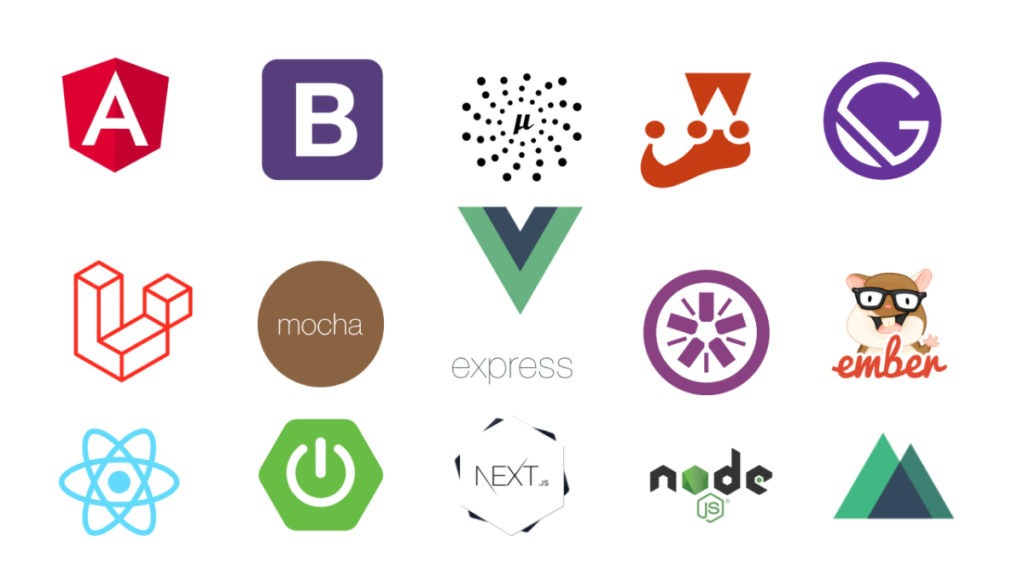What is web framework?
Web Development Framework, or Web Framework for short, is a software framework that provides supporting tools for web applications and development, namely online services, online resources, and Web Application Programming Interfaces (API).
These frameworks aim to automate common tasks in web development progress, provide web development standards, and design customizable conventions for websites.
Web development frameworks benefits

There are certain advantages web developers can gain from a web development framework. Here are some key points:
- Web Framework enhances code efficiency and reusability by offering a coding workspace on their computers. Certain traits, like hot reloading, can shorten the coding and development process.
- Web Framework decreases coding complexity and error by tracking and monitoring the development stage. The framework mainly considers what happens in the background, like configuration, so that web developers can focus on their primary application.
- Web Framework helps avoid lengthy code. Therefore, developers can work on simplified and condensed coding processes. This elimination is supposed to add functionality to a specific website, as web developers can initiate modification and bootstrap more easily.
- Web Framework reduces workload. Web developers can automate then-manual processes like URL mapping and caching authentication for a shorter time.
- Web Framework offers better security by preventing data manipulation, cyberattacks, distributed denial of services (DDoS), and many others.
- Web Framework makes debugging and maintenance easier. Since most frameworks contain testing and debugging, applications can be put to the test as a way of code practising and reusing. Features like code completion, unit testing, and simultaneous web testing will help update and maintain the app.
Types of frameworks for web development
1. Front-end web framework
The front-end framework, also known as the client-side framework, is used for dealing with user interfaces. To impress the customer, you must provide a good page experience. That’s why, besides building a stable website core structure, businesses must also focus on developing interactive, seamless, and user-centric website interfaces.
2. Back-end web framework
The back-end framework is the one working on the server side and assisting developers in making website structure. In other words, this type of framework will work with the server, database, interactive codes, modules, and numerous tools engaging in the development stage. The mission of the back-end web framework is to ensure the website’s functionality. Some common tasks are URL routing, user authenticating, security-enhancing, database interaction, and so on.
3. Front-end vs Back-end framework: The differences
There are certain distinctions between two frameworks for web development that developers of any level must notice:
- The front-end framework contains all the elements presented on the website to the users that are usually parts of the web. The back-end framework has all the features on the server and the background functioning of the web application, namely database, web server, operating system, etc.
- Front-end framework focuses on user interactions and offers pre-written code snippet, reusable templates, integrable elements. Back-end framework concentrates on user authorization, database manipulation, reusable components, and privacy encryptions;
- The most notable features of the front-end framework are UI/UX design, app performance and scalability enhancement, and SEO optimization. On the other hand, back-end framework deals with the server, site design and architecture, security, and URL routing.
- Front-end framework has HTML, CSS, JavaScript, JQuery, and other prevalent names as its primary languages. Python, JavaScript, PHP, NET., etc are a few of back-end coding languages;
- Some reputable front-end frameworks are: React JS, Angular, Vue JS, JQuery, and Ember. Ruby, Django, Laravel, Express, and ASP.net will be on the back-end side.
Top 5 frameworks for front-end web development
1. React JS
ReactJS is a web development framework by Meta. It is widely used for single-page front-end applications. Besides, it contributes to the development of mobile applications not supported by most mainstream frameworks.

React JS is quite easy to learn, flexible, and SEO-friendly. React.JS provides the finest server-side rendering and outstanding SEO support compared to other front-end frameworks. It can integrate and work effortlessly with other libraries to perform routing, state management, and API interaction activities.
Key features:
- React’s functionality enhancers, Virtual Document Object Model (DOM), for processing heavy-load applications, smoother performance, and quicker rendering;
- Front-end code is bundled into components;
- Reusability of data and code;
- Unidirectional information flow in React applications for fewer errors and easy debugging, making it more efficient;
- Flexibility on any user interface, including desktop, web, mobile, and smart TV.
Pros: Easy to connect with other libraries, supports mobile applications, has virtual DOM for quick document manipulation.
Cons: it has a complicated structure and unorganized documentation.
2. Angular
Angular was first presented in 2009, with JavaScript as its programming language. It was later updated in 2016 to use Typescript instead of JavaScript. Most web application development companies use Angular as their main front-end framework. One prominent feature of Angular is creating dynamic client-side web interfaces.
Angular is an enormous, inclusive framework with many controllers, libraries, directives, and other components. Its massive inclusivity is why learning Angular is more challenging than other languages. Angular is built on the Model-View-Controller (MVC) architecture and may be used to develop high-performance single-page apps.
Key features:
- Usage of repetitive coding with little to no changes (boilerplate coding) for less development time;
- Reusing codes and architecture for simplification of development process, testing process, and reduction of build time;
- Enhanced reusability and application scalability;
- Application of open-source libraries (Angular Material and AgGrid) for responsive, dynamic, and the multi-feature user interface;
- Angular CLI (Command Line Interface) for web maintenance, building, and scaffolding;
- Support of Chrome and Firefox Dev tools and extensions for web application debugging.
Pros: many available Angular JS services, supports MVC, two-way data binding, faster application developing process.
Cons: slow processing, unorganized documenting, challenging to learn.
3. Vue JS
VueJS is used for building single-page applications and their user interfaces. It was created in 2014 as an alternative to React and Angular for developing SPAs (Single Page Applications), high-performing and aesthetic user interfaces. The architecture used in Vue JS is Model-View-ViewModel (MVVM). It is a cutting-edge JavaScript framework that combines the pros of React.js (Virtual DOM) with Angular.js (View Layer).

Vue contains numerous tools and necessary features for making functional user interfaces. Vue can be easily integrated with any tools and solutions and is easy to learn. Gitlab, Netlify, 9GAG, Behance, Chess employ Vue JS as their primary web development framework.
Key features:
- Virtual DOM for better performance of applications and higher efficiency;
- Easy-to-use framework for web development due to more accessible scaffolding and prototyping;
- A time-saving solution for development projects;
- Reactive two-way data binding in Vue JS between User Interface (UI) and data;
- Integration with applications as libraries or modified modules for more flexible web application development;
- Easy download and instalment, lightweight;
- Fast launching, seamless user experience.
Pros: lightweight, easy to learn, suitable for rapid development, and can integrate with third-party apps.
Cons: Not supported by big tech companies like Google and Microsoft, not wholly stable tools.
4. JQuery
jQuery acts as an open-source JavaScript library applied for creating in-app user interfaces. It can make the simplistic approach and cross-browser compatibility with many others. The framework facilitates interaction between DOM elements and their syntactic structure. JQuery makes web pages more interactive by simplifying CSS animations, event handling, and Ajax calls. One significant advantage of utilizing JQuery is that it follows SEO-friendly principles.
The framework is notable for providing outstanding effects and animations inbuilt apps. jQuery does not take up much disk space and offers several plugins that allow simple functionality insertion into its framework. Because JQuery is basic and straightforward, creating significant JavaScript code does not need. WordPress, GeeksforGeeks, Bitbucket, Trello, Codepen, and more notable web applications employ JQuery as their main front-end framework.
Key features:
- Easy-to-modify DO elements in JQuery and simplify DOM manipulation;
- Quick-to-perform action sequences with just one click, shorter binding and unbinding processes.
- Many useful plugins for easy app development: Ajax helpers, data grids, XML and XSLT tools, dynamic lists, etc.;
- Combination of markup technologies (CSS, HTML, JavaScript) to produce animations (Flash) and responsive website;
- Achievable seamless integration between JavaScript and JQuery.
Pros: Easy to use, has extensive library, supported by open-source community, easy documenting.
Cons: JQuery JavaScript file is required to run it, limited functionalities in the frameworks.
5. Ember
Ember is considered the best JavaScript framework, offering outstanding features for developing highly functional apps. It is one of the most popular frameworks for creating single-page and dynamic client-side apps that may be enhanced with general idioms and advanced methods. LinkedIn, Apple, DigitalOcean, Intercom, and others are among the most prominent web applications that employ Ember JS.
HTML (Hypertext Markup Language) and CSS (Cascading Style Sheets) are at the heart of the development approach. Ember is also based on MVMM architecture and can be used quite easily. It eliminates unnecessary tasks and adopts some prominent JS practices to its core design for app development.
Key features:
- Two-way data binding;
- Backward compatibility, making even old applications adaptable and flawlessly function to new updates;
- Well-packaged associated tools;
- Complete front-end stack for URL management;
- Ember Inspector for debugging Ember applications;
- Embed.js’ automatic updates whenever application content changes.
Pros: delivers high performance, offers extensive and well-maintained documentation, supports code debugging.
Cons: challenging to learn, not great for smaller projects.
- Suggested for you: The List of 28 Best Front-end Web Development Tools
Top 5 frameworks for back-end web development
1. Ruby
Ruby, or Ruby on Rails, is one of the earliest frameworks for developing the back-end. It has been applied to 800,000 webs so far. Ruby supports applying complex algorithms to design functional logic for business issues. It promotes using well-known and valuable software engineering patterns and paradigms such as CoC (Convention Over Configuration), DRY (Don’t Repeat Yourself), and the active record pattern. The framework is suited for creating high-speed applications and database-driven applications.

Ruby contains powerful libraries and tools. Some reputable names built on Ruby are Airbnb, Hulu, and GitHub.
Key features:
- Promotion of web standards (XML, JSON) for data transfer, and languages like JavaScript, HTML, and CSS for user interaction;
- Powerful active record library for simplifying designing database queries;
- Numerous libraries for simplification of common programming tasks like form validation, session management, etc.;
- Tools to create a high-quality database access library, product AJAX library, and common tasks library;
- Flexible, concise, and simple Ruby syntax.
Pros: swift development, enables automation, massive libraries and available tools
Cons: slow processing, documentation can be improper.
2. Django
Django is a rare web framework that can work on both front-end and back-end processes. It is highly demanded among developers and businesses. Django follows Model-View-Template (MVT) architecture for faster app development and the concept of reusability. Django is the main back-end processor for corporations like Instagram, NASA, and Disqus.
It specializes in messaging, in-built validating, and authenticating. Django can be met in complex and enormous business projects.
Pros: quicker development, numerous inbuilt authentication tools available for use, supported by huge community, well-organized documenting.
Cons: challenging to learn, takes time to process.
3. Laravel
Laravel is a PHP-based framework built around the concepts and paradigms of the Hypertext Pre-processor (PHP) scripting language. It works on MVC architecture of back-end.
Laravel is adaptable and extensible thanks to its API support and numerous packages. It has an expressive, elegant syntax that allows developers to be creative and versatile while dealing with back-end complexities. Because of its variety, this is a popular choice among developers. Watchseries, Deltanet Travel, MyRank, Laracasts, Neighbourhood Lender, etc. are among the ones that deploy Laravel.
Key features:
- Quick and easy web applications deploying by MVC architecture;
- Several functions for security, scalability, and better performance;
- Built-in object-relational mapper (ORM) with PHP Active Record implementation for SQL-free database querying.
- High security with encrypted passwords;
- Light templates for layouts and content creation;
- Automating repetitive programming tasks using Artisan.
Pros: good documenting, back-end caching, mail services supported, newest PHP features available.
Cons: no payment gateways supported, not suitable for developing mobile apps.
Working with us, the leading Vietnamese real estate investment and development company has transformed their idea of a project website into reality with Lavarel and JQuery.
Not just showcasing pictures of the apartments, the client required us to integrate SVG canvas and Flash Paranoma Player, allowing customers to see the project more thoroughly and precisely. View the website!
4. Express
Express is a powerful NodeJS for creating robust web apps. Most major corporations and enterprises use it for its versatility.

Some notable built-in features and functionalities of NodeJS are party integrating, routing, server-side scripting, and routing. These noteworthy features are perfect for designing functional programs. Express gives off a minimalistic style and makes it easy for you to function.
Key features:
- Reduction of site’s loading time by elimination of repeated code execution;
- Advanced routine system for web state preservation;
- Convenient and detailed debugging;
- Easy HTML page design based on template engines: EJS, Jade, Pug, etc;
- Middleware system and several HTTP methods for quick build of Node.JS apps and APIs;
- Creating multi-page, single-page, and hybrid web applications.
Pros: highly flexible, packed with numerous features, suitable for API development.
Cons: undiversified call-backs, challenging to learn.
5. ASP.NET
Microsoft created ASP.NET for developers to keep up with web development trends and later create dynamic websites, services, and applications. It is an open-source web development framework for PC and mobile. ASP.NET’s newest version in 2016 enticed developers and businesses worldwide for its scalability, flexibility, and high-performance features.
It has a reputation for generating high-performing, secure, and modern applications. What’s more, it is compatible with many JavaScript front-end frameworks. Corporates like Taco Bell, Visual Studio, Dell, Stack Overflow is ASP.NET’s biggest applicator.
Key features:
- Seamless work with any client-side frameworks and wide-range deployment on platforms like MacOS, Window, Linux;
- Fast and improving app performance by ASP.NET’s asynchronous development;
- Combination Web API and MVC for more feasible client-side implementation and simplifying API creation;
- Quicker and more efficient building of server-side rendered apps;
- Seamless and fast application development experience from excellent developer tools.
Pros: wide range of storage customization, quick and speedy process due to less coding time, more flexibility and power, high security.
Cons: costly maintenance, unorganized documenting, unstable and relatively raw core.
Wrapping up
Here’s the top 10 best frameworks for web development. Choosing the right framework can have a huge impact on your business success. The right framework should save time and money, allow you to focus on your core business, and improve your web application’s quality.
How useful was this post?
Click on a star to rate it!
Average rating / 5. Vote count:
No votes so far! Be the first to rate this post.




